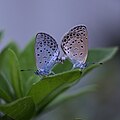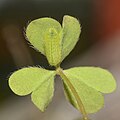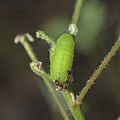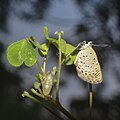Pseudozizeeria maha
| Pale grass blue | |
|---|---|

| |
| Scientific classification | |
| Domain: | Eukaryota |
| Kingdom: | Animalia |
| Phylum: | Arthropoda |
| Class: | Insecta |
| Order: | Lepidoptera |
| Family: | Lycaenidae |
| Genus: | Pseudozizeeria |
| Species: | P. maha
|
| Binomial name | |
| Pseudozizeeria maha (Kollar, 1844)
| |
| Synonyms | |
| |
Pseudozizeeria maha, the pale grass blue,[1][2] is a small butterfly found in South Asia that belongs to the lycaenids or blues family. The species was first described by Vincenz Kollar in 1844.[1][2][3]
Subspecies
[edit]The subspecies of Pseudozizeeria maha are-[3][1][2][4]
- Pseudozizeeria maha maha Kollar, 1844 – Pakistan, north and northeast India, Indochina
- Pseudozizeeria maha ossa Swinhoe, 1885 – south India
- Pseudozizeeria maha okinawana (Matsumura, 1929) – Okinawa
- Pseudozizeeria maha diluta (C. Felder & R. Felder, [1865]) – Yunnan
- Pseudozizeeria maha saishutonis (Matsumura, 1927) – Korea
- Pseudozizeeria maha argia (Ménétriès, 1857) – Japan
Description
[edit]Wet-season brood
[edit]
Male. Upperside silvery light blue with a satiny sheen in certain lights. Forewing: the apical half of the costa narrowly and the terminal margin for varying widths fuscous black, bounded outwardly on the latter by an obscure anteciliary black line. Hindwing: the costa broadly, the termen somewhat more narrowly fuscous black as in the forewing, with the width of this dark edging similarly variable; in addition there is a very diffuse and ill-defined subterminal series of spots darker than the fuscous margin. Underside: brownish grey. Forewing: a spot in cell, a transverse lunule on the discocellulars, and a transverse anteriorly inwardly curved series of eight discal spots, black; the transverse lunule and each spot encircled with a narrow white edging; the posterior two spots of the discal series geminate (paired). Beyond these are a postdiscal and a subterminal series of short transverse dusky black spots followed by an anteciliary black line; the ground colour between the discal and postdiscal series and between the latter and the subterminal series of spots posteriorly paler than on the rest of the wing. Hindwing: a transverse, subbasal, slightly sinuate line of four spots, a short, slender, lunular line on the discocellulars, and a very strongly curved discal series of eight small spots, black; the lunule and each spot encircled with a narrow edging of white; the posterior two spots of the discal series geminate as on the forewing; beyond these as on the forewing there is a double line of dusky spots, only more lunular, with between them and between the discal and postdiscal series the ground colour in the same way followed by slightly paler; an anteciliary fine black line. Cilia of both forewings and hindwings whitey brown, darker anteriorly on the forewing. Antennae, head, thorax and abdomen dark brown, shafts of the antennae ringed with white; in fresh specimens the thorax and abdomen with a little light blue pubescence; beneath: palpi, thorax and abdomen white.[5]
Female upperside: brownish black; the basal halves of the wings slightly suffused with light blue, anteciliary black lines on both forewings and hindwings, and on the latter wing an obscure subterminal series of spots as in the male. Underside, similar, only the ground colour darker, the markings larger and more clearly defined. Antennae, head, thorax and abdomen as in the male, but with no blue pubescence on the thorax and abdomen on the upperside.[5]
Dry-season brood
[edit]
Male upperside: pale bluish grey with, in some specimens, a pinkish undertone. Forewing: as in the wet-season brood, but the black terminal edging much reduced in width in some specimens to a transverse, somewhat diffuse, very narrow band that borders the anteciliary black line on the inner side, in others to a much broader similar band that coalesces with the anteciliary black line and occupies about the outer sixth of the wing. This edging along the termen is sometimes even, sometimes it widens from a slender anteciliary at and above the tornus to a broad black patch at the apex of the wing.[5]

Hindwing: the terminal black edging much narrower proportionately than in wet-season specimens, most often reduced to a slender black anteciliary line with a series of black spots on the inner side, bordering and sometimes coalescing with the line. Underside: as in the wet-season brood but the ground colour paler, in some specimens much paler, the markings on both forewings and hindwings similar, with frequently the terminal markings obsolescent, sometimes entirely absent or only indicated anteriorly on each wing. Cilia whitish. Antennae, head, thorax, and abdomen as in the wet-season specimens.[5]


Female similar to the female of the wet-season brood, but more like the male, with the light silvery-blue suffusion very irregular, but generally extended much further outwards from the base. Underside: as in the male, the ground colour slightly darker. Other variations exist:[5]
In a female from Poona, now before me, the fore wing on the upper-side has the basal half silvery blue, the outer half black; on the hind wing, however, the blue colour extends almost to the termen which is only narrowly edged with diffuse dusky black.
Antenna, head, thorax and abdomen similar to those of the male.[5][6]
Food plants
[edit]The eggs are laid on the host plants and the larvae hatch to feed on them. The plants include members of the Oxalidaceae including Oxalis corniculata, some Leguminosae and Acanthaceae.[7]
Other studies
[edit]A study in Japan used this species to detect the side-effects of transgenic Bt corn, particularly by way of pollen falling onto leaves of the Oxalis host plants. No significant effect was found in that study.[8]
Other Japanese studies showed increased abnormalities in individuals of this species subjected to radiation following the Fukushima Daiichi nuclear disaster.[9][10][11][12][13][14][15][16][17][18][19][20] Additionally, there are different studies on the recent migrations of the species to northern climates, where cold habitat leads to the increase of modifications of wing color pattern, found in northern margin populations of Japan.[21][22][23]
Gallery
[edit]-
Mating
-
Egg
-
1st instar caterpillar
-
2nd instar caterpillar
-
3rd instar caterpillar
-
4th instar caterpillar
-
5th instar caterpillar
-
Pupa
-
Freshly emerged
See also
[edit]References
[edit]- ^ a b c Varshney, R. K.; Smetacek, Peter (2015). A Synoptic Catalogue of the Butterflies of India. New Delhi: Butterfly Research Centre, Bhimtal & Indinov Publishing. p. 135. doi:10.13140/RG.2.1.3966.2164. ISBN 978-81-929826-4-9.
- ^ a b c Savela, Markku. "Pseudozizeeria maha (Kollar, [1844])". Lepidoptera and Some Other Life Forms. Retrieved July 3, 2018.
- ^ a b Inayoshi, Yutaka. "Zizeeria maha maha (Kollar, [1844])". Butterflies in Indo-China.
- ^ "Pseudozizeeria maha Kollar, 1844 – Pale Grass Blue". Retrieved 27 August 2017.
- ^ a b c d e f g
 One or more of the preceding sentences incorporates text from this source, which is in the public domain: Bingham, C. T. (1907). The Fauna of British India, Including Ceylon and Burma: Butterflies Volume II. London: Taylor and Francis, Ltd. pp. 355–357.
One or more of the preceding sentences incorporates text from this source, which is in the public domain: Bingham, C. T. (1907). The Fauna of British India, Including Ceylon and Burma: Butterflies Volume II. London: Taylor and Francis, Ltd. pp. 355–357.
- ^
 One or more of the preceding sentences incorporates text from this source, which is in the public domain: Swinhoe, Charles (1905–1910). Lepidoptera Indica: Volume VII. Vol. 7. London: Lovell Reeve and Co. pp. 253–255.
One or more of the preceding sentences incorporates text from this source, which is in the public domain: Swinhoe, Charles (1905–1910). Lepidoptera Indica: Volume VII. Vol. 7. London: Lovell Reeve and Co. pp. 253–255.
- ^ Robinson, Gaden S.; Ackery, Phillip R.; Kitching, Ian J.; Beccaloni, George W.; Hernández, Luis M. (2010). "Search the database - introduction and help". HOSTS - A Database of the World's Lepidopteran Hostplants. Natural History Museum, London. doi:10.5519/havt50xw.
- ^ Yoichi Shirai; Mami Takahashi (2005) Effects of transgenic Bt corn pollen on a non-target lycaenid butterfly, Pseudozizeeria maha Applied Entomology and Zoology 40(1):151-159 Full text[permanent dead link]
- ^ Hiyama, A.; Nohara, C.; Kinjo, S.; Taira, W.; Gima, S.; Tanahara, A.; Otaki, J. M. (2012). "The biological impacts of the Fukushima nuclear accident on the pale grass blue butterfly". Scientific Reports. 2: 570. Bibcode:2012NatSR...2E.570H. doi:10.1038/srep00570. PMC 3414864. PMID 22880161.
- ^ Callaway, Ewen (2013-07-16). "Fukushima offers real-time ecolab". Nature. 499 (7458): 265–266. Bibcode:2013Natur.499..265C. doi:10.1038/499265a. ISSN 0028-0836. PMID 23868240.
- ^ Nohara, Chiyo; Taira, Wataru; Hiyama, Atsuki; Tanahara, Akira; Takatsuji, Toshihiro; Otaki, Joji M. (2014-09-23). "Ingestion of radioactively contaminated diets for two generations in the pale grass blue butterfly". BMC Evolutionary Biology. 14 (1): 193. Bibcode:2014BMCEE..14..193N. doi:10.1186/s12862-014-0193-0. ISSN 1471-2148. PMC 4171559. PMID 25330067.
- ^ Taira, Wataru; Nohara, Chiyo; Hiyama, Atsuki; Otaki, Joji M. (2014-09-01). "Fukushima's Biological Impacts: The Case of the Pale Grass Blue Butterfly". Journal of Heredity. 105 (5): 710–722. doi:10.1093/jhered/esu013. ISSN 0022-1503. PMID 25124816.
- ^ Nohara, Chiyo; Hiyama, Atsuki; Taira, Wataru; Tanahara, Akira; Otaki, Joji M. (2014-05-15). "The biological impacts of ingested radioactive materials on the pale grass blue butterfly". Scientific Reports. 4 (1): 4946. Bibcode:2014NatSR...4E4946N. doi:10.1038/srep04946. ISSN 2045-2322. PMC 4027884. PMID 24844938.
- ^ Taira, Wataru; Hiyama, Atsuki; Nohara, Chiyo; Sakauchi, Ko; Otaki, Joji M. (2015-12-01). "Ingestional and transgenerational effects of the Fukushima nuclear accident on the pale grass blue butterfly". Journal of Radiation Research. 56 (suppl_1): i2–i18. doi:10.1093/jrr/rrv068. ISSN 0449-3060. PMC 4732531. PMID 26661851.
- ^ Hiyama, Atsuki; Taira, Wataru; Nohara, Chiyo; Iwasaki, Mayo; Kinjo, Seira; Iwata, Masaki; Otaki, Joji M. (2015-02-10). "Spatiotemporal abnormality dynamics of the pale grass blue butterfly: three years of monitoring (2011–2013) after the Fukushima nuclear accident". BMC Evolutionary Biology. 15 (1): 15. Bibcode:2015BMCEE..15...15H. doi:10.1186/s12862-015-0297-1. ISSN 1471-2148. PMC 4335452. PMID 25888050.
- ^ "Understanding Fukushima through Butterfly Biology: Academic Freedom for Scientists and the Public". thewinnower.com. Retrieved 2018-05-17.
- ^ "ICRP: ICRP 2015 Proceedings". www.icrp.org. Retrieved 2018-05-17.
- ^ Kazuo Sakai. "Integrated system of radiological protection of people and the environment A view from Japan" (PDF). 4th International Symposium on the System of Radiological Protection.
- ^ Iwata, Masaki; Hiyama, Atsuki; Otaki, Joji M. (2013-08-06). "System-dependent regulations of colour-pattern development: a mutagenesis study of the pale grass blue butterfly". Scientific Reports. 3 (1): 2379. Bibcode:2013NatSR...3E2379I. doi:10.1038/srep02379. ISSN 2045-2322. PMC 3753731. PMID 23917124.
- ^ Hiyama, Atsuki; Nohara, Chiyo; Taira, Wataru; Kinjo, Seira; Iwata, Masaki; Otaki, Joji M. (2013-08-12). "The Fukushima nuclear accident and the pale grass blue butterfly: evaluating biological effects of long-term low-dose exposures". BMC Evolutionary Biology. 13 (1): 168. Bibcode:2013BMCEE..13..168H. doi:10.1186/1471-2148-13-168. ISSN 1471-2148. PMC 3751199. PMID 23937355.
- ^ Otaki, JM; Hiyama, A; Iwata, M; Kudo, T (2010). "Phenotypic plasticity in the range-margin population of the lycaenid butterfly Zizeeria maha". BMC Evolutionary Biology. 10 (1): 252. Bibcode:2010BMCEE..10..252O. doi:10.1186/1471-2148-10-252. PMC 2931505. PMID 20718993.
- ^ Buckley, James; Bridle, Jon R.; Pomiankowski, Andrew (2010-12-09). "Novel variation associated with species range expansion". BMC Evolutionary Biology. 10 (1): 382. Bibcode:2010BMCEE..10..382B. doi:10.1186/1471-2148-10-382. ISSN 1471-2148. PMC 3014935. PMID 21143917.
- ^ Hiyama, Atsuki; Taira, Wataru; Otaki, Joji M. (2012). "Color-Pattern Evolution in Response to Environmental Stress in Butterflies". Frontiers in Genetics. 3: 15. doi:10.3389/fgene.2012.00015. ISSN 1664-8021. PMC 3277265. PMID 22363341.
General reading
[edit]- Evans, W.H. (1932). The Identification of Indian Butterflies (2nd ed.). Mumbai, India: Bombay Natural History Society.
- Gaonkar, Harish (1996). Butterflies of the Western Ghats, India (including Sri Lanka) - A Biodiversity Assessment of a Threatened Mountain System. Bangalore, India: Centre for Ecological Sciences.
- Gay, Thomas; Kehimkar, Isaac David; Punetha, Jagdish Chandra (1992). Common Butterflies of India. Nature Guides. Bombay, India: World Wide Fund for Nature-India by Oxford University Press. ISBN 978-0195631647.
- Haribal, Meena (1992). The Butterflies of Sikkim Himalaya and Their Natural History. Gangtok, Sikkim, India: Sikkim Nature Conservation Foundation.
- Kunte, Krushnamegh (2000). Butterflies of Peninsular India. India, A Lifescape. Hyderabad, India: Universities Press. ISBN 978-8173713545.
- Wynter-Blyth, Mark Alexander (1957). Butterflies of the Indian Region. Bombay, India: Bombay Natural History Society. ISBN 978-8170192329.









